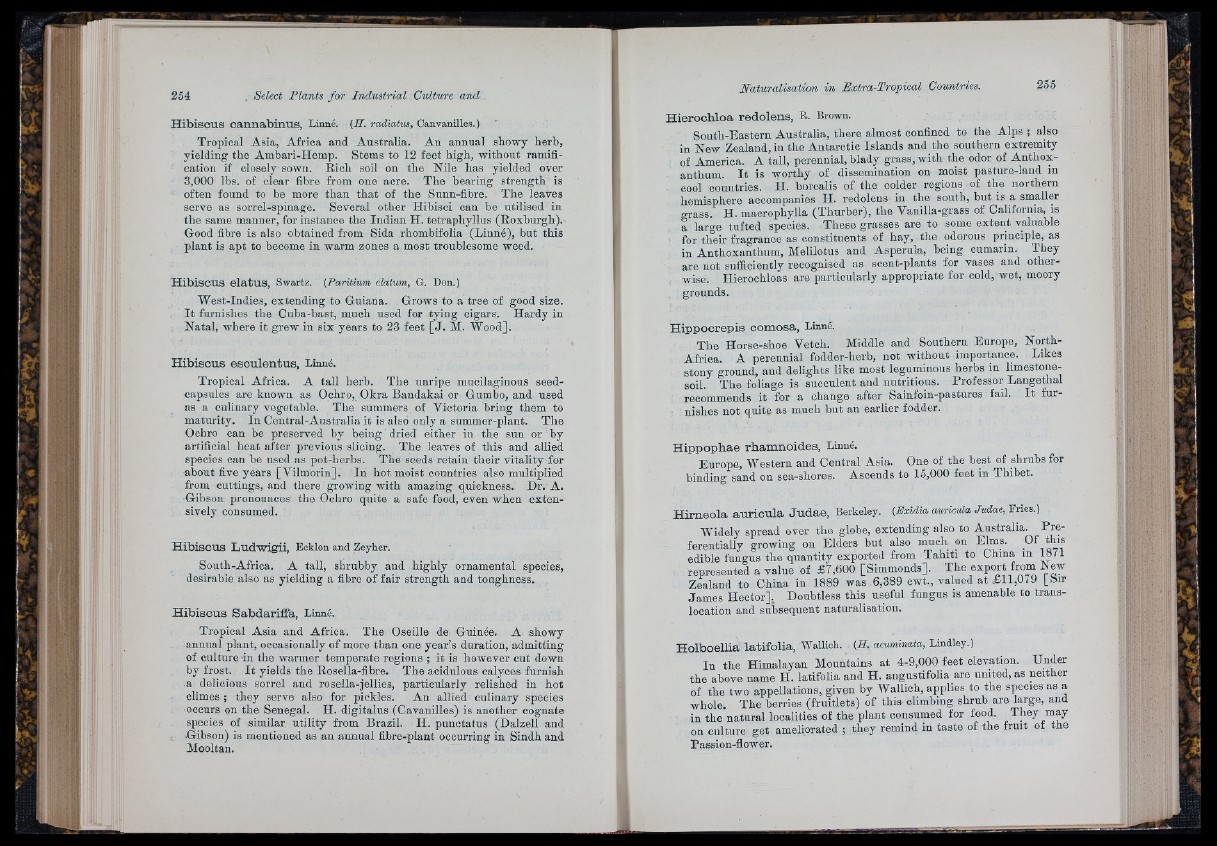
Hibiscus cannabinus, Linné. (H. radiatus, Canvanilies.)
Tropical Asia, Africa and Australia. An annual showy herb,
yielding the Ambari-Hemp. Stems to 12 feet high, without ramification
if closely sown. Rich soil on the Nile has yielded over
3,000 lbs. of clear fibre from one acre. The hearing strength is
often found to be more than that of the Sunn-fibre. The leaves
serve as sorrel-spinage. Several other Hibisci can be utilised in
the same manner, for instance the Indian H. tetraphyllus (Roxburgh).
Good fibre is also obtained from Sida rhombifolia (Linné), but this
plant is apt to become in warm zones a most troublesome weed.
Hibiscus elatus, Swartz. (Paritium elatum, G. Don.)
West-Indies, extending to Guiana. Grows to a tree of good size.
I t furnishes the Cuha-bast, much used for tying cigars. Hardy in
Natal, where it grew in six years to 23 feet [ J . M. WoodJ.
Hibiscus esculentus, Linné.
Tropical Africa. A tall herb. The unripe mucilaginous seed-
capsules are known as Ochro, Okra Baudakai or Gumbo, and used
as a culinary vegetable. The summers of Victoria bring them to
maturity. In Ceutral-Australia it is also only a summer-plant. The
Ochro can be preserved by being dried either in the sun or by
artificial heat after previous slicing. The leaves of this and allied
species can be used as pot-herbs. The seeds retain their vitality for
about five years [Vilmorin]. In hot moist countries also multiplied
from cuttings, and there growing with amazing quickness. Dr. A.
Gibson pronounces the Ochro quite a safe food, even when extensively
consumed.
Hibiscus Ludwigii, Ecklon and Zeyher.
South-Africa. A tall, shrubby and highly ornamental species,
desirable also as yielding a fibre of fair strength and toughness.
Hibiscus Sabdariffa, Linné.
Tropical Asia and Africa. The Oseille de Guinée. A showy
annual plant, occasionally of more than one year’s duration, admitting
of culture In the warmer temperate regions ; it is however cut down
by frost. I t yields the Eosella-fibre. The acidulous calyces furnish
■a delicious sorrel aud rosella-jellies, particularly relished in hot
climes ; they serve also for pickles. An allied culinary species
occurs on the Senegal. H. digitalus (Cavanilles) is another cognate
species of similar utility from Brazil. H. punotatus (Dalzell and
Gibson) is mentioned as an annual fibre-plant occurring in Sindh and
Mooltan.
Hierochloa reddens, K. Brown.
South-Eastern Australia, there almost confined to the Alps ; also
in New Zealand, in the Antarctic Islands and the southern extremity
of America. A tall, perennial, blady grass, w ith the odor of Anthoxanthum.
I t is worthy of dissemination on moist pasture-land in
cool countries. H. borealis of the colder regions of the northern
hemisphere accompanies H. redolens in the south, but is a smaller
grass. H. macrophylla (Thurber), the Vanilla-grass of California, is
a large tufted species. These grasses are to some extent valuable
for their fragrance as constituents of hay, the odorous principle, as
in Anthoxanthum, Melilotus and Aspernla, being cumarin. They
are not sufficiently recognised as scent-plants for vases and otherwise.
Hierochloas are partioularly appropriate for cold, wet, moory
grounds.
Hippoorepis comosa, Linné.
The Horse-shoe Vetch. Middle and Southern Europe, North-
Africa. A perennial fodder-herb, not without importance. Likes
stony ground, and delights like most leguminous herbs in limestone-
soil. The foliage is succulent and nutritious. Professor Langethal
recommends it for a change after Sainfoin-pastures fail. I t furnishes
not quite as much hut an earlier fodder.
Hippophae rhamnoides, Linné.
Europe, Western and Central Asia. One of the best of shrubs for
binding sand on sea-shores. Ascends to 15,000 feet in Thibet.
Hirneola auricula judae, Berkeley. (Exidia auricula Judae, Fries.)
Widely spread over the globe, extending also to Australia. P re ferentially
growing on Elders but also much on Elms. Of this
edible fungus the quantity exported from Tahiti to China in 1 ^ 1
represented a value of £7,600 [Simmonds]. The export from New
Zealand to China in 1889 was 6,389 cwt., valued a t £11,079 [S ir
James Hector]. Doubtless this useful fungus is amenable to translooation
and suiasequent naturalisation.
Holboellia latifolia, Wallich. (H. acuminata, Lindley.)
In the Himalayan Monntains at 4-9,000 feet elevation. Under
the above name H. latifolia and H. angustifolia are united, as neither
of the two appellations, given by Wallich, applies to the species as a
whole. The berries (fruitlets) of this climbing shrub are large, and
in the natural localities of the plant consumed for food. They may
on culture get ameliorated ; they remind in taste of the fruit of the
Passion-flower.